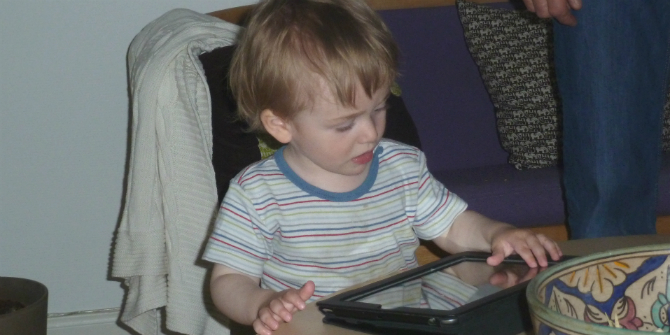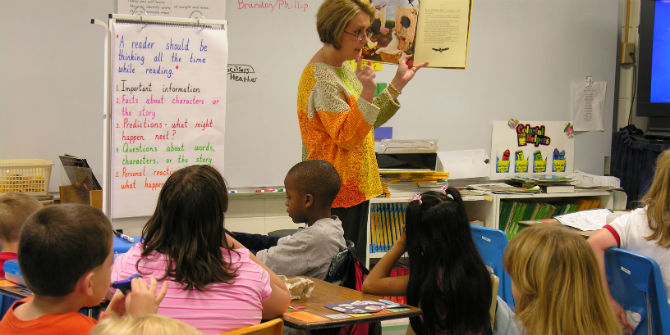 Sonia Livingstone takes a closer look at the complex links between technology and society to understand both continuities and change between the past and present. She says that we can already see that children are the focus of intense speculation about the meaning of these transitions. Sonia is Professor of Social Psychology at LSE’s Department of Media and Communications and has more than 25 years of experience in media research with a particular focus on children and young people. She is the lead investigator of the Parenting for a Digital Future research project. [Header image credit: D. Skley, CC BY-ND 2.0]
Sonia Livingstone takes a closer look at the complex links between technology and society to understand both continuities and change between the past and present. She says that we can already see that children are the focus of intense speculation about the meaning of these transitions. Sonia is Professor of Social Psychology at LSE’s Department of Media and Communications and has more than 25 years of experience in media research with a particular focus on children and young people. She is the lead investigator of the Parenting for a Digital Future research project. [Header image credit: D. Skley, CC BY-ND 2.0]
‘The digital’, most simply, means encoding information in binary symbols and transmitting it across connected devices. But its meaning in social terms is hotly debated. Is ‘digital’ or ‘virtual’ reality distinct from the ‘real world’? Or isn’t it all ‘real’ now, as the boundaries between on/offline blur?
So, does it matter if we read a bound paperback novel or an eBook? If our music is broadcast or downloaded or live-streamed? Many would say ‘yes’, that the quality of our experiences with media is changing. Underlying these changing experiences lie important changes in the business of media, with implications for companies’ business models, customer relations and the data being collected about us.
If it matters that our media are becoming digital, shall we take a step further and describe our lives as ‘digital lives’? Consider the now-commonplace talk of ‘digital parenting’ or ‘digital natives’ or ‘digital learning’. Perhaps such talk is just a way of sounding up to date about parenting or youth or education. But the more we learn of technological innovations – think of smart homes and smart cities, drones and wearable technology, the internet of things, implants and robots – the more it seems that our lives may be changing fundamentally.
When policy-makers try to imagine, and researchers try to track empirically, what ‘the digital’ really means, they often emphasise the complex links between technological and social change. What’s important here is to recognise the continuities between the past and present, as well as a measure of change (rather than radical transformation) in human experience. Our media environment can be characterised in four key ways, as I identified with Leah Lievrouw:
- Interactivity. Far more than for mass communication (broadcasting, the press), interactive media allow audiences to speak back to producers, information receivers to search and query databases, and publics to hold powerful institutions to account. While some of this could happen before, such opportunities were less accessible and rarely scalable. But these new opportunities pose new challenges, as we must now navigate what danah boyd has called the collapsed contexts of new media, with their shifting norms and uncertain audiences. In principle, everyone can now ‘have their say’, but in practice, most lack the symbolic or material resources to do so. And even when they do, today’s cacophony of voices makes it hard to be heard – although a few new voices are being heard, both globally and among peer networks or niche groups.
- Networked. We can no longer neatly contrast interpersonal communication (usually face-to-face, physically co-located) and mass communication (usually one-way, at a distance). Converged and networked technologies make for multiple forms of communication, some familiar, but some new. Networks are heterarchical, non-centralised, characterised by numerous workarounds, niche groupings and backchat. There are many network effects to contend with – from the new-found viability of the long tail, to the unpredictable visibility of messages that ‘go viral’; from new ways to search for information or manage its ‘discoverability’, to new tools by which we can be tracked, assessed and monetised.
- Remix culture. Now that digital content can be replicated, remixed and reproduced in ways unanticipated by the original content producers, the very notions of original and copy, producer and consumer are changing. Many people can now edit, create and share content, ‘writing themselves into being’, and extending collaborative peer practices of knowledge, learning and action. The consequences may be democratic, opening up new spheres for public expression and contestation, or they may be anti-democratic, creating crises of trust and authenticity, and permitting political or commercial intervention in what counts as knowledge.
- Ubiquitous. While not everyone has access to the internet worldwide (although some argue for internet access as a human right), everyone is affected by the satellite communications that scan, record and connect all parts of the globe. Thus all human life is affected by what social theorist David Harvey calls time-space compression – as technology links up the world ever more intensively and efficiently, with a host of consequences for the economy (e.g. new forms of profit), politics (e.g. new ways of being excluded), culture (e.g. multiculturalism or extremism) and everyday experience (e.g. time speeding up, risk-related anxieties, intimacies at a distance).
In other words, to say that we live in ‘a digital age’ is to emphasise that our lives are inextricably linked with interactive, networked, remixable and ubiquitous media. It is not to say that our lives bear no relation to those of previous generations, or that we understand the consequences of living in our current socio-technological environment, or that we know what is yet to come. So does it matter that we live in a ‘digital age’? At present, we are mainly aware of the many ambiguities, uncertainties and anxieties of the digital age, although we are fascinated, too, by the potential for enhanced autonomy, on the one hand, or exploitation, on the other.
In this blog, our emphasis is on people’s everyday experiences, while recognising that these are shaped by larger forces of change. This means that, as we research ‘parenting for a digital future’, we are interested in how people think about and try to manage socio-technical change, including how they cope with the personal risks associated with changes often beyond their control. We can already see that children are the focus of intense speculation – for parents and for the wider society – about the meaning of these changes. In forthcoming posts, we will report from our fieldwork on the diverse ways in which parents, teachers and young people are responding to the ‘digital age’ in their own terms.






